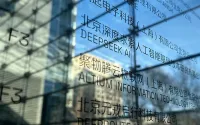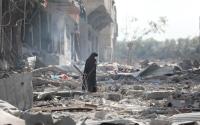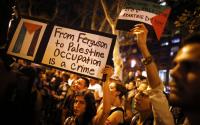Common Dreams / Published on Wednesday, December 1, 2004 by the Washington Post
A confidential report to Army generals in Iraq in December 2003 warned that members of an elite military and CIA task force were abusing detainees, a finding delivered more than a month before Army investigators received the photographs from Abu Ghraib prison that touched off investigations into prisoner mistreatment.
The report, which was not released publicly and was recently obtained by The Washington Post, concluded that some U.S. arrest and detention practices at the time could "technically" be illegal. It also said coalition fighters could be feeding the Iraqi insurgency by "making gratuitous enemies" as they conducted sweeps netting hundreds of detainees who probably did not belong in prison and holding them for months at a time.
The investigation, by retired Col. Stuart A. Herrington, also found that members of Task Force 121 -- a joint Special Operations and CIA mission searching for weapons of mass destruction and high-value targets including Saddam Hussein -- had been abusing detainees throughout Iraq and had been using a secret interrogation facility to hide their activities.
Herrington's findings are the latest in a series of confidential reports to come to light about detainee abuse in Iraq. Until now, U.S. military officials have characterized the problem as one largely confined to the military prison at Abu Ghraib -- a situation they first learned about in January 2004. But Herrington's report shows that U.S. military leaders in Iraq were told of such allegations even before then, and that problems were not restricted to Abu Ghraib. Herrington, a veteran of the U.S. counterinsurgency effort in Vietnam, warned that such harsh tactics could imperil U.S. efforts to quell the Iraqi insurgency -- a prediction echoed months later by a military report and other reviews of the war effort.
U.S. treatment of detainees remains under challenge. Representatives of the International Committee of the Red Cross recently told U.S. military officials that the treatment of inmates held at Guantanamo Bay, Cuba, was "cruel, inhumane and degrading" (story, Page A10). Herrington's report, which was commissioned by Maj. Gen. Barbara Fast, the top intelligence officer in Iraq, said some detainees dropped off at central U.S. detention facilities other than Abu Ghraib had clearly been beaten by their captors.
"Detainees captured by TF 121 have shown injuries that caused examining medical personnel to note that 'detainee shows signs of having been beaten,' " according to the report, which later concluded: "It seems clear that TF 121 needs to be reined in with respect to its treatment of detainees."
A group of Navy SEALs who worked as part of the task force has been charged with abuse in connection with the deaths of two detainees they arrested in the field. One died in a shower room at Abu Ghraib on Nov. 4, 2003, a month before Herrington arrived for his review.
A military source who participated in Task Force 20, the predecessor to TF 121, said the task forces comprised several 12-man units that had targeted missions, such as searching for Hussein loyalists and terrorists. TF 20, which had about 1,000 soldiers, incorporated Army Rangers, members of Delta Force and Special Forces units working with CIA agents. They planned their missions nearly autonomously and answered either directly to the theater commander or to officials in Washington, the source said, speaking on the condition of anonymity because the missions were classified.
Task Force 121 added Navy SEAL units but was slightly smaller overall. Herrington wrote that an officer in charge of interrogations at a high-value target detention facility in Baghdad told him that prisoners taken by TF 121 showed signs of having been beaten.
Herrington asked the officer whether he had alerted his superiors to the problem, and the officer replied: "Everyone knows about it."
While several investigations have been completed into the Abu Ghraib scandal and U.S. interrogation practices in Iraq, an official military inquiry into the detention activities of Special Operations forces has not been released. That probe, headed by Brig. Gen. Richard P. Formica, was expected to be presented to Congress earlier this year, but a Pentagon spokesman said it is ongoing.
Of the Herrington report, a Pentagon official said top generals in Iraq, including Lt. Gen. Ricardo S. Sanchez, who at the time directed U.S. forces there, reported the alleged abuses to officials at U.S. Central Command, which oversees military activities in the Middle East. The official said TF 121 was investigated, but he could not provide results.
"The Herrington report was taken very seriously," said the official, who spoke on the condition of anonymity because the report has not been released.
The report also provided an early account of the practice of holding some detainees -- sometimes called "ghost detainees" -- in secret and keeping them from international humanitarian organizations. Herrington also wrote that agents from other government agencies, which commonly refers to the CIA, regularly kept ghost detainees by not logging their arrests.
Nearly six months later, Defense Department officials were forced to acknowledge the practice because of the Abu Ghraib scandal. Soldiers who worked at the prison said several detainees were hidden, and a prison logbook showed a consistent stream of them from October 2003 to January 2004.
Herrington, who is considered an expert in human intelligence operations, ran programs during Operation Desert Storm and in Panama and was part of the controversial Phoenix Program, which targeted the roots of the Viet Cong insurgency in Vietnam. He compiled his report after a week-long trip to Iraq beginning Dec. 2, 2003, joined by a military intelligence officer and an Army intelligence official from the Pentagon.
His ultimate conclusion was that much needed to be done to increase intelligence capabilities, which he called below average, though he praised Fast's determination.
"Given the fact that the United States and its coalition partners paid and continue to pay a steep price in losses and national treasure to lay our hands on these detainees, it is disappointing that the opportunity to thoroughly and professionally exploit this source pool has not been maximized, in spite of your best efforts and those of several hundred MI [military intelligence] soldiers," Herrington wrote to Fast in the Dec. 12 report. "Even one year ago, we would have salivated at the prospect of being able to talk to people like the hundreds who are now in our custody. Now that we have them, we have failed to devote the planning and resources to optimize this mission."
Herrington, contacted by telephone, declined to discuss the report. A Pentagon official said Fast personally requested Herrington's visit, and the report indicates Fast was interested in improving U.S. intelligence and detention operations, saying that "in spite of efforts to upgrade this effort, [she] remained concerned about its state of health."
In the 13-page report, Herrington wrote that overcrowding and a lack of resources caused the Army to use "primitive prison accommodations" for even the most important targets. He said that led to the loss of considerable significant intelligence and might have fueled the Iraqi insurgency.
He added that some detainees were arrested because targets were not at home when homes were raided. A family member was instead captured and then released when the target turned himself in -- a practice that, Herrington wrote, "has a 'hostage' feel to it."
A separate report by the Center for Army Lessons Learned, issued this past May and intended for internal use, gave the sense that some Army tactics served to "alienate common Iraqis who initially supported the coalition."
The 134-page CALL report singled out the practice of detaining female family members to force wanted Iraqi males to turn themselves in, similar to Herrington's findings.
"It is a practice in some U.S. units to detain family members of anti-coalition suspects in an effort to induce the suspects to turn themselves in, in exchange for the release of their family members," the report stated. The CALL report also was critical of the delays in notifying family members about the status of detainees held in U.S. custody, reminding family members of Hussein's tactics.
Herrington's report also noted that sweeps pulled in hundreds and even thousands of detainees who had no connection to the war. Abu Ghraib, for example, swelled to several thousand more detainees than it could handle. Herrington wrote that aggressive and indiscriminate tactics by the 4th Infantry Division, rounding up random scores of detainees and "dumping them at the door," was a glaring example.
As the United States recently has picked up its counterinsurgency efforts, the number of new detainees has again surged.
"Between the losers and dead end elements from the former regime and foreign fighters, there are enough people in Iraq who already don't like us," Herrington wrote. "Adding to these numbers by conducting sweep operations . . . is counterproductive to the Coalition's efforts to win the cooperation of the Iraqi citizenry. Similarly, mistreatment of captives as has been reported to me and our team is unacceptable, and bound to be known by the population."
Staff writer Thomas E. Ricks contributed to this report.






